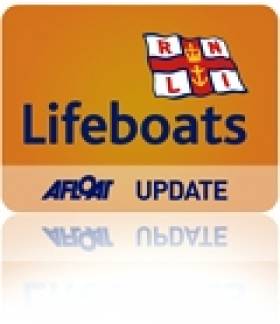Displaying items by tag: Old Head of Kinsale
The Old Head of Kinsale Lighthouse in west Cork is closed to the public for most of the year, however there will be a rare opportunity for the public to enter the lighthouse next month.
Locals and tourists alike will have a chance to witness the stunning views from inside the 30 metre high Old Head of Kinsale Lighthouse that was designed by Inspector George Halpin.
Permission has been granted by the Old Head Golf Links and the Commissioners of Irish Lights to raise funds during two days in May.
The fundraising is for the development of the Old Head Signal Tower and Lusitania Museum.
The Open Days will be held on the weekend of Saturday, 13th and Sunday, 14th May.
The lighthouse at the Old Head is one of the major lights on the south coast and also serves as a guide to the entrance of Kinsale Harbour, which is to the east of the light.
The light was first established on 1st October 1853 and the current range of the light is 20 nautical miles.
YayCork has more details on the open days.
Major New Lusitania Museum Planned for Old Head of Kinsale
The community group at the renowned South Coast landmark, the Old Head of Kinsale, plans to build a major, new Lusitania Museum to replace the present small museum at the site, where they have also constructed a memorial garden.
The memorial committee is also the owners of the Lusitania wreck. Still, their concentration is on creating a new museum, "to mark fully a huge part of Irish maritime history is," the Secretary of the committee told Afloat. "Every sailor who passes on the South Coast knows the Old Head very well."
They have begun a campaign to raise €150,000 to prepare an application for Planning and intend to seek Irish government and European Commission support funding.
 Lusitania Memorial Garden at The Old Head of Kinsale. A davit from the Lusitania points to the wreck site
Lusitania Memorial Garden at The Old Head of Kinsale. A davit from the Lusitania points to the wreck site
The Old Head is a place I know and remember well, particularly through a classic boat, the Mab. This grand old 27-foot classic couldn't match the power of every wave that hit her at the Old Head, sometimes shoving her bowsprit straight through. But she got lifted as big ones swept beneath the hull, the bowsprit then pointing skywards. She'd been through too many seas in her years to bother lifting herself to everyone, so my Skipper said.
 The MAB at the Glandore Classics 1996. Owner and Skipper the late Guy Perrem sitting at the mast. Ron Holland in the cockpit helming, Tom MacSweeney on the stern
The MAB at the Glandore Classics 1996. Owner and Skipper the late Guy Perrem sitting at the mast. Ron Holland in the cockpit helming, Tom MacSweeney on the stern
Above us, the black-and-white banded lighthouse looked down. We were on our homeward voyage to Monkstown Bay Sailing Club from a Glandore Classic Boats Regatta, where the Mab was a regular and winning performer. Skipper and owner, the late Guy Perrem, did not doubt her ability to get past the Old Head where we had arrived with unfortunate timing. "Bit lumpy, but we'll get through," said he as he sought extra push from the inboard engine to support sail power. A bit wet, we did.
This stretch of water, where the coastline of County Cork thrusts out to meet the Atlantic, is well-known to legions of Irish sailors and foreign visitors. It can provide plenty of challenges at varying tidal moments!
That battle with the Old Head came to mind this week when the community group which developed the memorial garden and mini-museum there to the Lusitania, sunk 12 miles to the south by a German submarine on May 7, 1915, during World War One, told me of their decision to build an extensive, new museum. They also own the wreck, given to them by former owner American multi-millionaire Greg Bemis. 1,198 were killed in the sinking.
Con Hayes, Secretary of the Memorial Committee, joins me on this week's Podcast to outline their plans which will interest every sailor who has ever passed by the Old Head.
Kinsale Farmland Inviting Final Offers
A former farm in Kinsale with spectacular sea views is inviting final offers by private treaty.
The 370-acre waterfront property was formerly the proposed location for the Kinsale Harbour Resort. The land is laid out in flat fields with good road frontage, and is available in one or two lots.
Lot 1 comprises 270 acres of land at Ballymachus and Rathmore, while lot 2 is 100 acres at Hangman's Point, Prehane, overlooking the entrance to Kinsale Harbour with top-class views of the Old Head of Kinsale, Charles Fort and the town itself.
Christy Buckley Auctioneer advises that the land may be suitable for leisure use, subject to planning.
For images and a video of the site, as well as maps and further details, visit the Christy Buckley Auctioneer website HERE.
Lifeboat Rescues Two Near Old Head of Kinsale
The Kinsale RNLI Lifeboat was launched at 5.15 pm on Sunday afternoon to go to the aid of a 17ft Mastercraft, with two passengers on board, which had lost power and was anchored one mile east off the Old Head of Kinsale.
Sunday was one of the busiest sailing days of the summer, with very crowded seas. The distressed craft did not have a radio on board. Their only means of contact with shore was a weak mobile phone signal. Thankfully conditions were flat and visibility good, so helmsman Temba Jere and crew members Mark Lewis and Ian Fitzgerald were able to locate the boat and tow it back to the safety of Kinsale Harbour within 40 minutes.
Related Safety posts
RNLI Lifeboats in Ireland
Safety News
Rescue News from RNLI Lifeboats in Ireland
Coast Guard News from Ireland
Water Safety News from Ireland
Marine Casualty Investigation Board News
Marine Warnings






























































